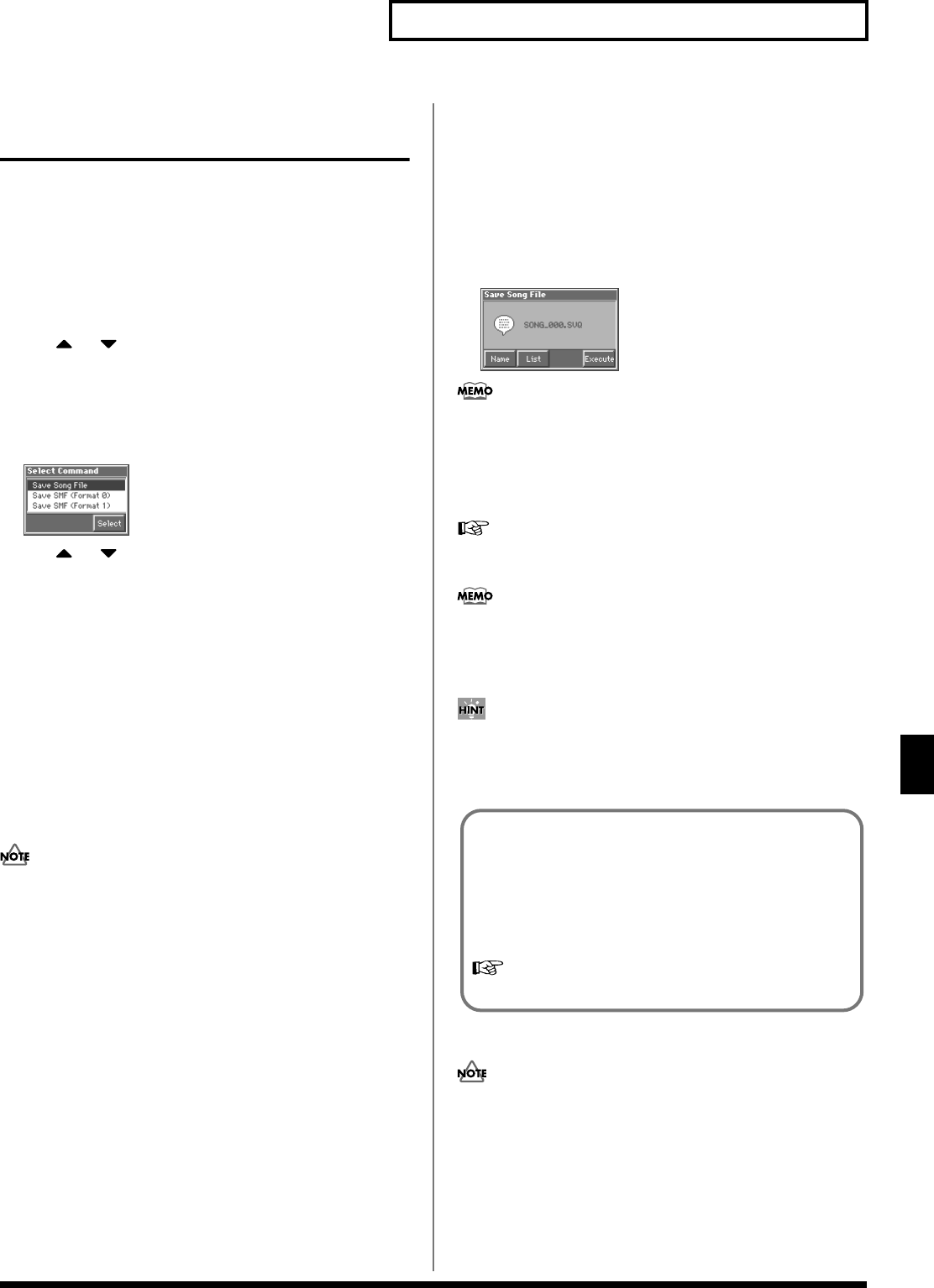
135
Recording Songs
Recording Songs
Saving a Recorded Song on
Disk
A song you record is temporarily stored in internal memory. A song
in internal memory will be lost when the power is turned off or
when you load another song. If you want to keep the song, you must
save it to disk.
1. Into the disk drive, insert the disk on which you will save the
song.
2. Press [MENU] to access the Menu window.
3. Use or to select “Song Edit,” and then press [8
(Select)].
The Song Edit screen appears.
4. Press [2 (Save)].
The Select Command window appears.
fig.10-13_50
5. Use or to select the format in which the song will be
saved.
Save Song File: The song will be saved to disk in MRC Pro song
format. The settings of the currently selected multitimbre/
performance will also be saved with the data. An extension of
“.SVQ” will be added automatically.
Save SMF (Format 0): The song will be converted into a Format 0
Standard MIDI File (in which all sequencer data is saved in a single
phrase track), and saved to disk. An extension of “.MID” will be
added automatically.
Save SMF (Format 1): The song will be converted into a Format 1
Standard MIDI File (in which the sequencer data is saved in multiple
phrase tracks), and saved to disk. An extension of “.MID” will be
added automatically.
• The extension will be “.MID” for both “Save SMF (Format 0)”
and “Save SMF (Format 1).” These two cannot be distinguished.
• When you save the data using “Save Song File,” the settings of
the patches and rhythm sets assigned to each part of the
multitimbre/performance will not be saved.
• When you save the data using “Save Song File,” the
multitimbre/performance settings at the time you saved the data
will be saved. This means that if the multitimbre/performance
was modified midway through the song, and you save
immediately after recording, the song will start with the
multitimbre/performance sounds that were selected at the time
of saving. If you modify the multitimbre/performance during
the song, use the Microscope window to record the desired bank
select and program number data (corresponding to the
multitimbre/performance settings from which you will start) at
the beginning of the song (p. 156).
• Even if you save using “Save Song File,” the song will not use
the correct sounds when played back on a MRC Pro sequencer
other than the Fantom. In order to make the song play back with
the correct songs, you must record the appropriate bank select
and program number in the song.
6. After specifying the format in which the song will be saved,
press [8 (Select)].
The Save **** window appears.
fig.10-14_50
The window title will depend on the format in which the song is
being saved.
7. Assign a file name (up to 8 characters). Press [5 (Name)],
and use the Name window that appears to assign a file
name.
For details on assigning a name, refer to “Assigning a Name”
(p. 30).
If a song name has already been assigned to the song, the first
eight characters of the song name will be used to automatically
assign a file name. If no song name has been assigned,
“SONG_000” will be assigned automatically.
If you want to view a list of the files stored on disk, press [6
(List)]. To select a file name from this list, move the cursor to the
desired file and press [8 (Select)].
8. Press [8 (Execute)] to execute the operation.
• If you assign a file name that is the same as the name of a file
already existing on the disk, then attempt to save it, a message of
“File “****” Already Exists! Over Write OK?” will appear. If you
want to overwrite the existing file, press [7 (OK)]. If you decide
to cancel without saving, press [8 (Cancel)].
• If you attempt to save data to a disk that has not been formatted
by the Fantom, a message of “Unformatted Disk” will appear.
Please format the disk on the Fantom (p. 191).
File Name and Song Name
MRC Pro songs and Standard MIDI Files have a song name in
addition to a file name. The file name is used to distinguish
between files, and must be assigned when you save a file. It will
help you manage songs if you use the file name to distinguish
between types of song, and use the song name to assign a title.
Use the Song Name window to assign a song name (p. 137).
